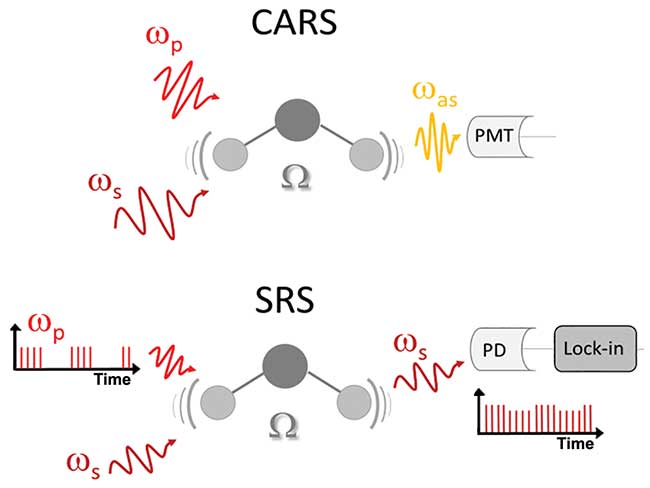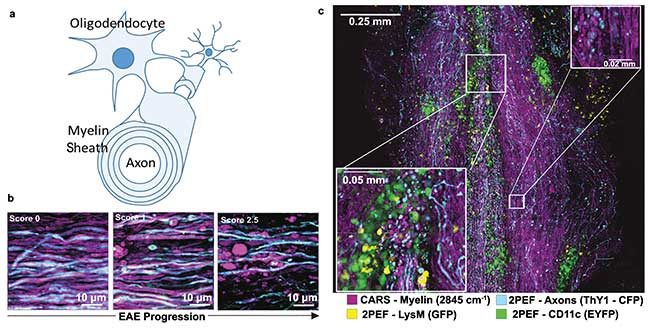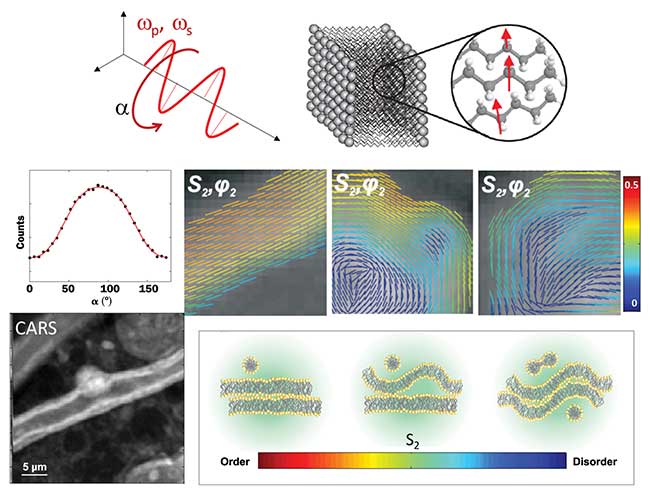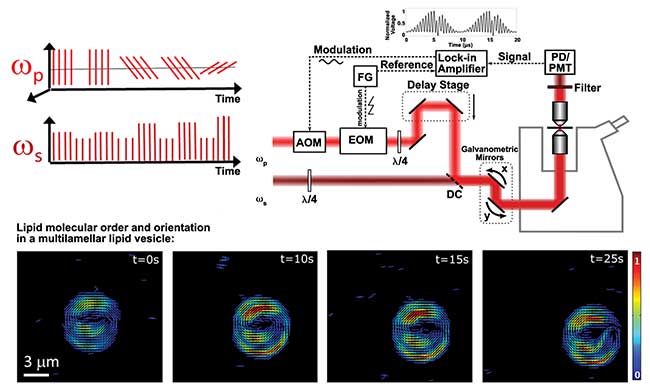An in-depth, real-time optical method may help refine diagnoses of neurological diseases.
SOPHIE BRASSELET, INSTITUT FRESNEL
The neurosciences are still searching for imaging methods capable of better assisting researchers and clinicians with accurate diagnoses, appropriate treatments and a greater understanding of the origin of neurological diseases.
Recent imaging modalities have partially concentrated on the observation of the myelin sheath around axons, which ensures their electrical insulation. Myelin is made of highly packed lipid multilayers that are severely damaged in the progression of neurological disorders such as Alzheimer’s1, Parkinson’s2 and multiple sclerosis (MS). Demyelination, which describes a loss of myelin with relative preservation of axons, is at the origin of important lesions found in the brain and spinal cord white matter. Myelin imaging thus potentially offers a noninvasive diagnosis for abnormalities that are indicators of these disorders.
Imaging myelin in vivo is typically done by magnetic resonance imaging (MRI). However, the spatial scale is far above the single axon. Researchers seek better resolution methods able to evaluate quantitatively and noninvasively demyelination processes at early stages and at small scales. Ultimately, visualizing loss of adhesion of lipid layers, swelling and detachment from the axon can help refine diagnosis toward more targeted drugs.
Among the optical methods that can reach this goal, there is a growing interest in coherent Raman scattering (CRS) microscopy, which presents the advantage of being sensitive to specific chemical vibration bonds with submicrometric resolution, including from CH2 vibration modes in myelin lipids3.
CRS is generated from the illumination of the sample by two synchronized pulsed lasers in the near-infrared regime at the Stokes (ωs) and pump (ωp) frequencies (Figure 1). The frequency difference matches the molecular vibration bond frequency (?r) to be measured. CRS has been developed along two modalities: Coherent anti-Stokes Raman scattering (CARS), which results from a nonlinear induced anti-Stokes radiation (at the frequency ωas = 2ωp− ωs) that is enhanced at the resonance condition ωp − ωs = ?r4, and stimulated Raman scattering (SRS), which measures a transfer of modulation from the pump to the Stokes or vice versa, under such resonant conditions4.

Figure 1. Coherent anti-Stokes Raman scattering (CARS) and stimulated Raman scattering (SRS) principle showing a molecular vibration mode excited by both Stokes and pump laser beams. PMT: photomultiplier. PD: photodiode. Lock-in: lock-in detection. Courtesy of S. Brasselet, Institut Fresnel Marseille.
CARS and SRS are powerful tools to monitor the presence of specific molecules in cells and tissues with in-depth, real-time imaging capabilities, as shown by the Cheng group in the myelin lipid imaging in the mouse brain5. Myelin also has been imaged by CARS in nerves of the peripheral nervous system6 and spinal cord tissues7,8, including for experimental autoimmune encephalomyelitis (EAE), which is the mouse model for MS8.
Importantly, CARS and SRS are also compatible with reflectance microscopy7 and two-photon excitation fluorescence (2PEF), benefiting from distinct two-photon excitation wavelengths at 2ωp , 2ωs and (ωp + ωs). Using multicolor 2PEF intravital imaging in the central nervous system through a spinal glass window, the Debarbieux group has quantified the cell recruitment dynamics and their interaction with axons for both infiltrating and resident cells, over the long term in the same animals with spinal cord injury9. Adding the CARS modality has helped visualize myelin, axons and specific cells in fixed spinal cords of EAE mice (Figure 2), which is promising for future in vivo applications.

Figure 2. Schematic representation of myelin around an axon (a). CARS imaging (at 2845 cm-1, vibrational bond frequency of CH2 in lipids) of demyelination at different progression scores of the disease in experimental autoimmune encephalomyelitis (EAE) mice (b). CARS imaging of myelin and 2PEF imaging of cells and axons in the fixed spinal cord of an EAE transgenic mouse (clinical score 2.5) (c). Courtesy of P. Gasecka, N. Kumar Balla, S. Brasselet, Institut Fresnel Marseille, and F. Debarbieux, Institut de Neurosciences de la Timone.
CRS imaging is capable of evaluating myelin fibers’ morphology. However, the method as such still misses the molecular-
scale alterations that form the early-stage mechanisms of demyelination and still cannot resolve the scale necessary to visualize lipid layers’ loss of adhesion.
It has been recently discovered that CRS microscopy can do more than pure morphological imaging. Elements added on a CRS microscope controlling light polarization — which fixes the direction of its electric field oscillation — can increase sensitivity to molecular organization, for example, lipid order inside a focal spot of typically 300 nm8 (Figure 3).

Figure 3. Polarization-resolved (PR)-CARS showing a rotation of polarization focused on a lipid bilayer, exhibiting preferred orientations of the CH2 bonds. A combined representation shows, on the top of a CARS image, the amplitude (stick color, called S2) and phase (stick orientation, called φ2) of the molecular order per pixel. A model shows the expected lipid organization behavior after data analysis (the green circle represents the excitation focal spot size). Courtesy of P. Gasecka, N. Kumar Balla, S. Brasselet, Institut Fresnel Marseille. See reference 8.
Polarization-resolved CRS (PR-CRS) requires rotating the incident linear polarization of the incident light (either the pump or both pump and Stokes), and recording the consequent modulation of the CARS signal. This rotation is generally provided by an achromatic half-wave plate in a motorized rotation mount at the entrance of the microscope. A CARS image (typically 100 μm × 100 μm scale) is formed at each incident polarization angle from 0 to 180°.
The number of images to record (typically five to 10) is decided by the signal-to-noise level. In regions of the sample where molecular bonds are oriented, the detected intensity at ωas is modulated; in other words, it is maximized when the incident polarizations lie along the averaged direction of the bonds’ distribution. A post-processing of the recorded stack allows deducing molecular organization (molecular order) and mean orientation at each pixel of the image8. The molecular order is given by the amplitude of the signal modulation, and its orientation is deduced from the phase of this modulation. The Cheng group has proven the applicability of polarized CARS to myelin5, followed by demonstrations in fixed tissues in the mouse brain6, sciatic nerves and the spinal cord of mice8.
More recently, quantitative analysis of PR-CRS in myelin has shown that local deformations of the membrane at ~100-nm scale (below the diffraction limit size) are visible8. This is at the scale at which membrane contour rupture or loss of lipid layer adhesion occurs. Early alteration of the myelin sheath of EAE mice occurs at the molecular level, while the membrane architecture at a more macroscopic scale is robust and mostly preserved until the formation of myelin debris8.
Methods using motorized rotations of a polarization are strongly limited for in vivo imaging because of their long time acquisition. Typical molecular order imaging is performed at the rate of minutes for sequential polarization tuning on
150 × 150-pixel images. This timescale is essentially limited by the point scanning modality required for CRS imaging, with obvious inconvenience of sensitivity to sample motion and lack of dynamics information.
High-speed (up to MHz) electro-optical polarization modulation (EOM) of the pump beam (using a circularly polarized stokes beam), together with lock-in amplification detection10, can circumvent this limitation. In packed lipid layers where CH2 molecular bonds are highly organized, a fast modulation of the pump linear polarization will induce a fast modulation of the Stokes signal because of the variation of the energy transfer efficiency from high (molecular bonds parallel to the pump polarization) to low (molecules bonds perpendicular to the pump polarization).
In contrast to traditional SRS, which monitors pure intensity energy transfer, this transfer occurs here only in regions of the sample where molecules are aligned, the measured modulation giving simultaneously amplitude (lipid order) and phase (lipid orientation) information (Figure 4). This modality can be combined with intensity modulation of the pump beam by acousto-optic modulation (AOM), to provide SRS intensity maps. This PR-SRS polarization scheme is also applicable to PR-CARS10.

Figure 4. Fast polarization-resolved SRS. The polarization of the pump beam (180 fs pulses at 781 nm) is modulated by electro-optical polarization modulation (EOM) at 100 kHz, while the modulation transfer is measured on the Stokes beam (180 fs pulses at 1004 nm). The pump beam is further amplitude-modulated by acousto-optic modulation (AOM) at 2 MHz. The measured signal is split into two independent input channels of the lock-in, which are simultaneously demodulated. Courtesy of M. Hofer, N. Kumar Balla, Institut Fresnel Marseille. See reference 10.
The fast-polarization SRS image has been obtained at the rate of one image per second, which is two orders of magnitude faster than the regular SRS image using the same incident powers, number of pixels and dwell time per pixel. Increasing the EOM modulation frequency from the 100 kHz to MHz regime is expected to reach even higher acquisition rates (subsecond for large images), with more favorable noise rejection in the lock-in amplification.
At this stage, the data are not spectrally resolved within the CH-based lipids’ vibration bands, which, among other measurements, prevents discrimination of saturated and unsaturated lipids. Future directions can be envisioned that will study more precisely the origin of the observed phenomena by adding chemical specificity. In particular, a higher degree of lipid unsaturation has been reported in demyelination lesions made of degraded pathological myelin, a feature that is associated with the early formation of lipid-packing disorder.
With this method, it is possible to diagnose lipid loss of organization at the early stage of neurological disease progression, even before any clear morphological sign of damage. Ultimately, if applied to mice in vivo, this methodology could monitor demyelinating disease progression over long time lapse, label free and specifically. Future prospects are under study to extend this methodology to endoscopy, a field that is rapidly progressing for CARS and SRS imaging, to reduce or eliminate the need for tissue resection in neurosurgical diagnosis.
Meet the author
Sophie Brasselet is a research director at Aix Marseille University, CNRS, Institut Fresnel, Marseille, France; email: [email protected].
References
1. C. Carmeli et al. (2013). Demyelination in mild cognitive impairment suggests progression path to Alzheimer’s disease. PLoS One, Vol. 8, p. e72759.
2. D.C. Dean et al. (2016). Alterations of myelin content in Parkinson’s disease: A cross-sectional neuroimaging study. PLoS One, Vol. 11, p. e0163774.
3. J.-X. Cheng and X.S. Xie (2015). Vibrational spectroscopic imaging of living systems: An emerging platform for biology and medicine. Science, Vol. 80, p. 350.
4. B.G. Saar et al. (2010). Video-rate molecular imaging in vivo with stimulated Raman scattering. Science, Vol. 330, p. 1368.
5. Y. Fu et al. (2008). Ex vivo and in vivo imaging of myelin fibers in mouse brain by coherent anti-Stokes Raman scattering microscopy. Opt Express, Vol. 16, p. 19396.
6. G. de Vito et al. (2014). RP-CARS: Label-free optical readout of the myelin intrinsic healthiness. Opt Express, Vol. 22, p. 13733.
7. J. Imitola et al. (2011). Multimodal coherent anti-Stokes Raman scattering microscopy reveals microglia-associated myelin and axonal dysfunction in multiple sclerosis-like lesions in mice. J Biomed Opt, Vol. 16, p. 021109.
8. P. Gasecka et al. (2017). Lipid order degradation in autoimmune demyelination probed by polarized coherent Raman microscopy. Biophys Journal, Vol. 113, p. 1520.
9. K.K. Fenrich et al. (2013). Long and short-term intravital imaging reveals differential spatiotemporal recruitment and function of myelomonocytic cells after spinal cord injury. J Physiol, Vol. 591, p. 4895.
10. M. Hofer et al. (2017). High-speed polarization-resolved coherent Raman scattering imaging. Optica, Vol. 4, p. 795.